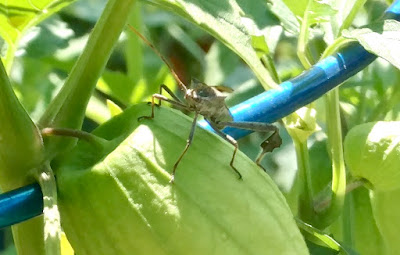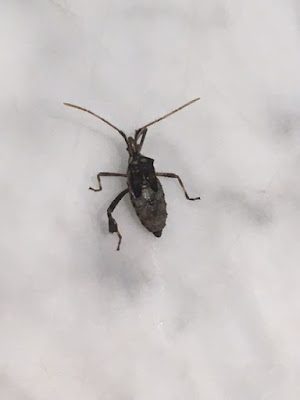
Leaffooted bugs go through transformations as they mature

|
|
This is not a good bug to find in your vegetable
garden: It's a Leptoglossus zonatus , a leaffooted bug. (Photo: Debbie Arrington) |
Just when you think you can tell a good bug from a bad bug, Mother Nature throws you a curve.
Some bugs transform into several different forms – called instars – before they fully mature. They keep molting and going through various stages of metamorphosis until they become complete (and much more recognizable) adults.
Right now in Sacramento gardens, multiple generations of leaffooted bugs are scrambling over our tomatoes. They’re not only different ages, but different species, and some of those bad babies mimic good bugs.
The leaffooted bug, a stink bug cousin, gets its nickname from the leaflike extensions on its back legs. The nymphs generally stick together for protection. The adults can fly and are much more mobile.
A fellow gardener at Fremont Community Garden found one on his tomatoes, and wondered if it might be an assassin bug, which is a predatory insect and considered a garden good guy.
Usually, the leaffooted bugs we see at Fremont, located in Midtown Sacramento, have little zigzag stripes and they’re pretty big – over an inch tall. That’s Leptoglossus zonatus .

|
|
A
Leptoglossus occidentalis
, a type of leaf-
footed bug. (Photo courtesy Alan Moritz)
|
But it’s still a leaffooted bug, an immature Leptoglossus occidentalis . If you look closely, you can see the beginnings of those back “leaves.”
According to the UC Cooperative Extension pest notes, leaffooted bug populations tend to swell in late June and early July.
“Overwintering leaffooted bugs can lay over 200 eggs during a two-month period in the spring,” say the pest notes. “Nymphs emerge from the eggs about 1 week after being deposited, after which they develop into adults in 5 to 8 weeks.
"Adults are long-lived and can lay eggs over an extended period, so the population can consist of all life stages by late June. At this time, overwintering adults are still alive as the first generation of their offspring develop into adults.”
Throughout the summer, two to three generations of leaffooted bugs may be coexisting in the garden at the same time. And they’re all hungry. They go after tomatoes (in particular) but are a real pain on pomegranates, too, as well as a wide range of other fruits and vegetables.
The best way to combat them: Knock them off the plant into a pail or dishpan of water with 1 teaspoon dish soap (to break surface tension). They can’t swim and they’ll drown.
They tend to scramble sway from people, so slip the container under the tomatoes, then make motions from above or gently shake the vine’s trellis. The bugs will hop off the fruit – and right into the water. For pomegranates, gently shake the fruit over water; the baby bugs will fall out of the fruit’s blossom end.
For more on identifying and combating leaffooted bugs: http://ipm.ucanr.edu/PMG/PESTNOTES/pn74168.html
Comments
0 comments have been posted.Sacramento Digs Gardening to your inbox.
Sites We Like
Garden Checklist for week of July 21
Your garden needs you!
* Keep your vegetable garden watered, mulched and weeded. Water before 8 a.m. to reduce the chance of fungal infection and to conserve moisture.
* Feed vegetable plants bone meal, rock phosphate or other fertilizers high in phosphate to stimulate more blooms and fruiting. (But wait until daily high temperatures drop out of the 100s.)
* Don’t let tomatoes wilt or dry out completely. Give tomatoes a deep watering two to three times a week.
* Harvest vegetables promptly to encourage plants to produce more. Squash especially tends to grow rapidly in hot weather. Keep an eye on zucchini.
* Pinch back chrysanthemums for bushy plants and more flowers in September.
* Remove spent flowers from roses, daylilies and other bloomers as they finish flowering.
* Pinch off blooms from basil so the plant will grow more leaves.
* Cut back lavender after flowering to promote a second bloom.
* It's not too late to add a splash of color. Plant petunias, snapdragons, zinnias and marigolds.
* From seed, plant corn, pumpkins, radishes, winter squash and sunflowers.